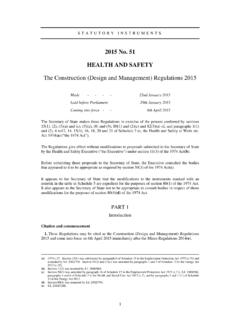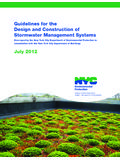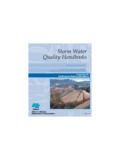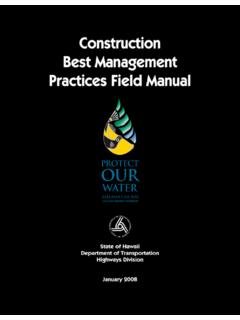Transcription of Revision of the Construction (Design and Management ...
1 CONSULTATIVEDOCUMENTR evision of the Construction ( design and Management ) regulations (CDM) 1994, Construction ( health , Safety andWelfare) (CHSW) regulations 1996, Approved Code ofPractice (ACoP) and GuidanceThe Commission tries to make its consultation procedure as thorough and open as possible. Responses to thisconsultative document will be lodged with the health and Safety Executive s Information Centres after the closeof the consultation period where they can be inspected by members of the public or be copied to them onpayment of the appropriate fee to cover to this consultative document are invited on the basis that anyone submitting them agrees to theirresponse being dealt with in this way.
2 Responses, or part of them, will be withheld from the Information Centresonly at the express request of the person making them. In such cases, a note will be put in the index to theresponses identifying those who have commented and have asked that their views, or part of them, be treated business e-mail systems now automatically append a paragraph stating the message is confidential. If youare responding to this CD by e-mail and you are content for your responses to be made publicly available, pleasemake clear in the body of your response that you do not wish any standard confidentiality statement to consultative document is issued by the health and Safety Commission in compliancewith its duty to consult, under sections 16(2) and 50(3)
3 Of the health and Safety at Work 1974, bodies which appear to it to be appropriate before submitting proposals for themaking of regulations and the issue of Approved Codes of can be supplied online at: sent to:Paul CunninghamHealth and Safety ExecutiveConstruction Policy5SW, Rose Court2 Southwark BridgeLondon SE1 9 HSTel: 020 7556 2175 Fax: 020 7556 2209e-mail: reach him no later than 29 July 2005 Further single copies of this document may be obtained from HSE Books see back coverConsultative Document on the Revision of the Construction ( design and Management ) regulations (CDM) 1994, Construction ( health , Safety and Welfare) (CHSW) regulations 1996, Approved Code of Practice (ACoP) and GuidanceCONTENTSPage(s)
4 Summary1-2 Introduction3 Outline and explanation of HSC s proposals 3-21 What to do if you are dissatisfied with the way this consultation has been done 22 How to respond and who to contact 163 Data Protection 163 ANNEXESA nnex A Draft regulations in full 23-57 Annex B Draft Guidance 58-129 Annex C Regulatory Impact Assessment (Pre Consultation) 130-162 Annex D Copy of response questionnaire to fill in by hand164 -173 1 Consultative Document (CD) sets out the health and Safety Commission s (HSC) proposals for a single set of regulations , and supporting guidance, covering Construction work in Great Britain.
5 The proposed regulations would consolidate and revise provisions in the Construction ( design and Management ) (CDM) regulations 1994a and the Construction ( health , Safety and Welfare) (CHSW) regulations 1996b, which implemented the Temporary or Mobile Construction Sites Directive (TMCS) (1992/57/EEC) proposals build on the general principles of CDM and experience of its implementation and take account of the responses to the 2002 Discussion Document (DD) Revitalising health and safety in Construction and other feedback from industry. They reflect the HSC and Construction Industry Advisory Committee (CONIAC) commitment that the Revision exercise should improve the Management of risk, and therefore ensure responsibility is placed with those in the best position to influence or manage it.
6 Aim to simplify and clarify what duty holders need to do, so that they can easilyidentify and understand their own role (and those of other members of the project team). To make it easier to understand the various responsibilities, we have restructured the proposed regulations , to group their requirements by duty holder. We have also tried to makeapplication of the regulations and guidance simpler and more suitable, and the proposals more compatible with less-traditional procurement part of this process, and reflecting responses to the DD, what remains of the CHSW regulations , after the amendments due to the new Work at Height regulations , now formsthe basis of Schedules 2 and 3 of the proposed single set of revised CDM have used the experience and knowledge gained, in the 10 years since the CDM regulations were first in place.
7 To make changes we believe will be effective in raising health and safety standards in the industry. We think they allocate responsibilities in a practical and proportionate way. If you believe they do not, or there are problems of practical application that have not been identified, we would like to hear from you in response to this consultation proposals recognise the influence of clients on the whole process, and seek to encourage clients and all members of their project teams to communicate and work effectively together, from the start to the end of the project, to ensure health and safety issues are identified and addressed.
8 To ensure services and adequate welfare facilities are providedfrom the start of Construction work, and to help provide a level playing field for prospective Principal Contractors (PC) to price for such facilities, clients are required to state at the tender stage how much notice of mobilisation will be assist clients in discharging their duties, we have replaced the Planning Supervisor (PS) with a new role the co-ordinator to provide advice and support. The co-ordinator s role has evolved from that of the PS, but is re-enforced (in tandem with the client s duties) to create an empowered and key advisor to the client, and pivotal figure in ensuring an effective and cohesive project team.
9 We have not lost sight of the fact that good health and safety has commercial benefits too: better quality, and more chance of the project being completed on a Statutory Instrument (SI) No. 1994/3140, as amended by SIs 1996/1592, 1998/494, 1999/3242 and 2000/2380b SI No. 1996/1592, as amended by SIs 1998/494, 1998/2306, 1998/2307 and 1999/3242c The TMCS Directive is currently implemented in Great Britain mainly through the CDM and CHSWR egulations. The full text of Directive 57 of 1992 can be found at 2 time and coming in on budget because the site will be better managed.
10 We see the co-ordinator as being instrumental in ensuring have considerable potential to reduce the risks associated with constructionwork, as well as those associated with building use, maintenance, cleaning, and eventual demolition. The proposals reflect this. The principles are largely unchanged, but revisedrequirements clarify the factors they must take into account when exercising their professional judgement. The aim is to encourage designers to focus on what they can do, in the design , to eliminate hazards, where possible, and reduce the risks resulting from any that are no substantial changes regarding the PC or contractors, except to makeexplicit, in the proposed regulations , the PC s key role in managing the Construction phase; and the contractor s duty to plan, manage and monitor their own work to ensure that it is carried out in accordance with the plan and, so far as is reasonably practicable, safely and without risk to health .

















